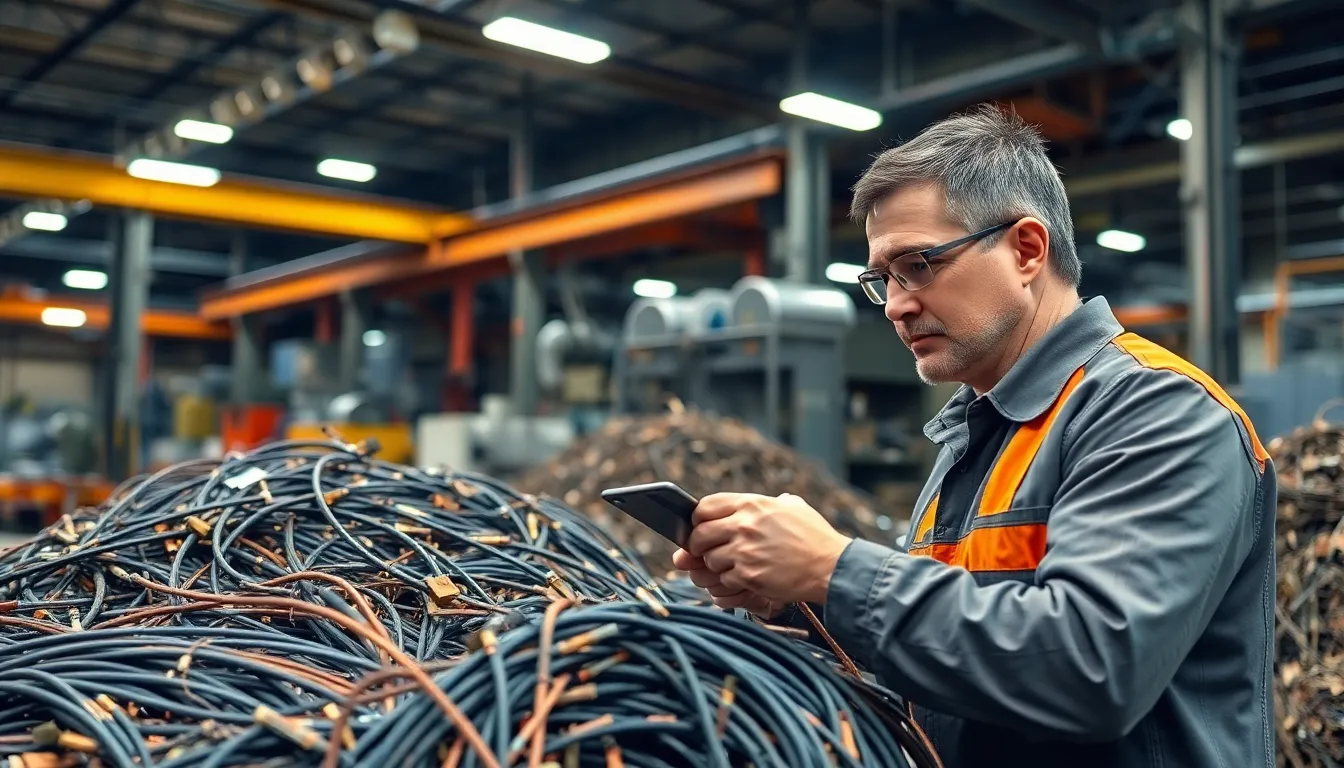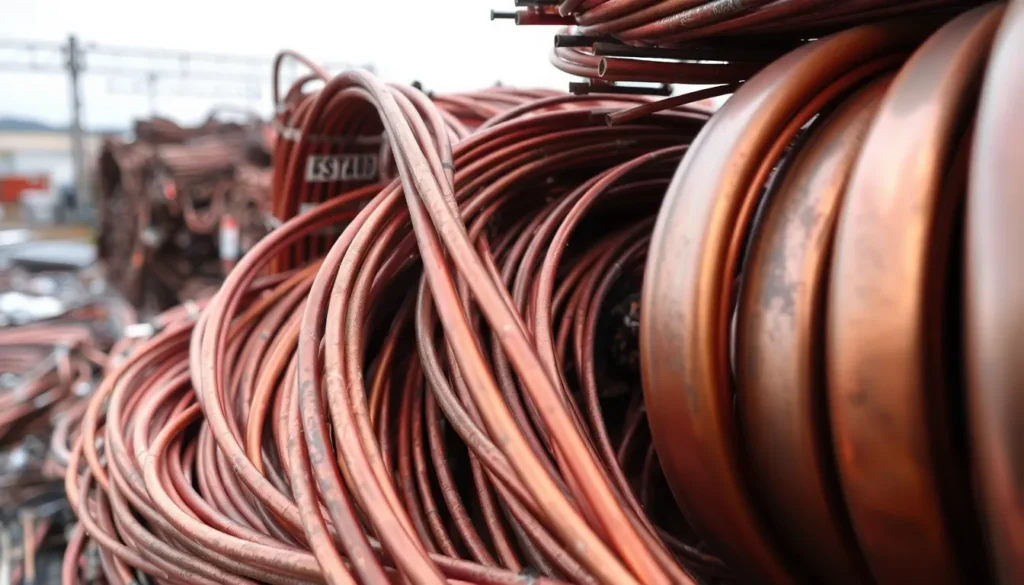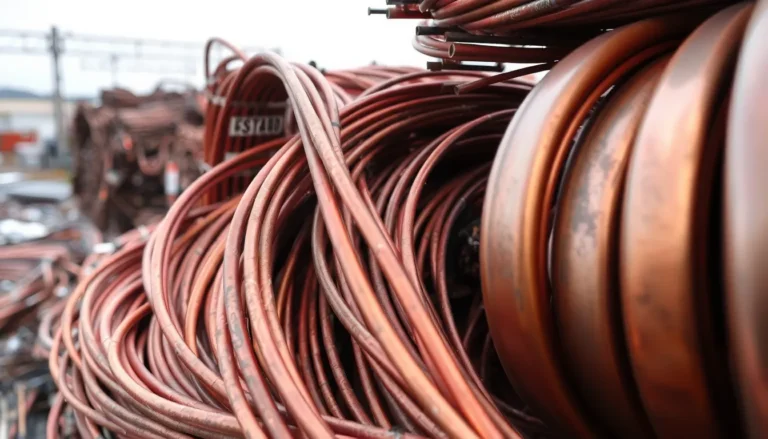Copper’s not just a pretty face in the electrical world; it’s the unsung hero of countless industries. As technology advances and the demand for renewable energy skyrockets, the future of scrap copper prices is hotter than a jalapeño in July. Investors and recyclers alike are sharpening their pencils and calculators, eager to decode the crystal ball of copper pricing.
Table of Contents
ToggleOverview of Scrap Copper Market
Copper’s importance spans multiple industries, including construction, automotive, and electronics. Increased demand for renewable energy projects, such as solar panels and wind turbines, drives the necessity for copper. Recycling scrap copper provides an effective means to meet this growing need while promoting sustainability.
Market dynamics influence scrap copper prices significantly. Global economic conditions, trade agreements, and production rates in mining sectors contribute to fluctuating values. Supply chain disruptions can also affect availability, further impacting market pricing.
Current trends indicate a potential rise in scrap copper demand, given the push for green technologies. Investors monitor emerging technologies closely, preparing for shifts in pricing that might occur as the industry evolves. Recent data shows that recycled copper usage has steadily increased, highlighting its role in reducing environmental impact and conserving resources.
Price predictions rely on various factors, including market supply and demand balance. Analysts note that ongoing geopolitical tensions may result in uncertainty within the copper market. Potential changes in regulations concerning environmental policies can also impact pricing.
Understanding the scrap copper market helps industry players make informed decisions. Keeping abreast of developments in the copper sector becomes essential for recyclers and investors alike. With an eye on future trends, they can better navigate the complexities of the market and capitalize on emerging opportunities.
Factors Influencing Scrap Copper Prices

Several factors influence scrap copper prices, reflecting market volatility and industry trends. Understanding these elements helps investors and recyclers navigate the market effectively.
Economic Indicators
Economic indicators play a crucial role in pricing. GDP growth rates indicate industrial activity, directly impacting copper demand. Employment levels also reflect economic health; higher employment leads to higher consumer spending and infrastructure investments. Inflation rates affect purchasing power, influencing commodity pricing. Interest rates can change borrowing costs for businesses, indirectly impacting demand for copper. Monitoring these indicators provides valuable insights into future pricing trends.
Supply and Demand Dynamics
Supply and demand dynamics significantly shape scrap copper prices. Increased demand for new technologies and renewable energy projects elevates copper requirements. At the same time, mining production rates determine supply levels. Geopolitical tensions may disrupt mining operations; natural disasters can also affect output. Scrap copper availability relies on recycling efforts that meet evolving technological needs. Understanding this balance is essential for predicting market shifts in scrap copper pricing.
Historical Trends in Scrap Copper Prices
Analyzing historical trends in scrap copper prices reveals substantial fluctuations influenced by various factors. From 2000 to 2023, prices rose significantly, with the average price per pound reaching over $3 in 2022 before experiencing volatility in subsequent years. Historical data indicates that prices soared during economic booms, particularly driven by demand in construction and renewable energy sectors.
The global financial crisis of 2008 caused a steep decline, showcasing how economic downturns impact copper pricing. In contrast, recovery periods often lead to sharp increases as industrial activity rebounds. Seasonal demand also plays a crucial role, with higher prices typically observed during spring and summer months when construction projects peak.
Recent years have underscored the impact of geopolitical tensions. Trade disputes and sanctions have frequently led to price spikes, reflecting uncertainty in the market. Factors like mining production rates further contribute to trends, as any disruptions in supply chains tend to increase prices due to diminished availability.
Notably, the evolution of environmental regulations has affected historical prices. Increased recycling efforts have mitigated demand pressures, promoting sustainability in the copper industry. Between 2010 and 2020, the push for greener technologies consistently pushed scrap copper prices upward, highlighting the material’s essential role in renewable energy projects.
Monitoring these historical trends provides valuable insights into future price predictions. Investors and recyclers can gauge potential shifts based on past performance while considering current market dynamics. Understanding these historical patterns aids stakeholders in navigating the complexities of the scrap copper market effectively.
Future Scrap Copper Price Predictions
Predictions regarding scrap copper prices focus on emerging trends and market dynamics. Many experts anticipate continued fluctuations based on global economic conditions and demand from renewable energy projects.
Expert Analysis and Forecasts
Analysts forecast a steady increase in scrap copper prices over the next few years. Several factors contribute to this outlook, including the strong demand for electric vehicles and renewable energy technologies. Increased adoption of solar panels and wind turbines also drives consumption. Market experts suggest that geopolitical stability and trade agreements could further influence price stability. Significant investments in sustainable infrastructure are expected to support this growth, reinforcing the idea of higher prices as demand swells.
Market Trends and Insights
Market trends show a clear shift toward sustainability, with rising demand for recycled materials. Copper’s essential role in green technologies, such as electric vehicles, continues to attract attention. Data indicates that supply chain disruptions may push prices higher, as mining production levels struggle to meet growing needs. Seasonal fluctuations also affect the market, with demand peaking during construction seasons. Tracking these trends provides valuable insights that help investors and recyclers make informed decisions, maximizing opportunities in the evolving market landscape.
The future of scrap copper prices appears promising as demand continues to rise in key sectors. With the ongoing transition to renewable energy and the growing emphasis on sustainability, the market is likely to see increased interest from both investors and recyclers.
Fluctuations will remain a challenge influenced by economic conditions and geopolitical factors. However, the overall trend points toward higher prices driven by the urgent need for copper in electric vehicles and green technologies.
As the industry adapts to these changes, staying informed about market dynamics will be crucial for those looking to navigate the complexities of scrap copper pricing effectively.




